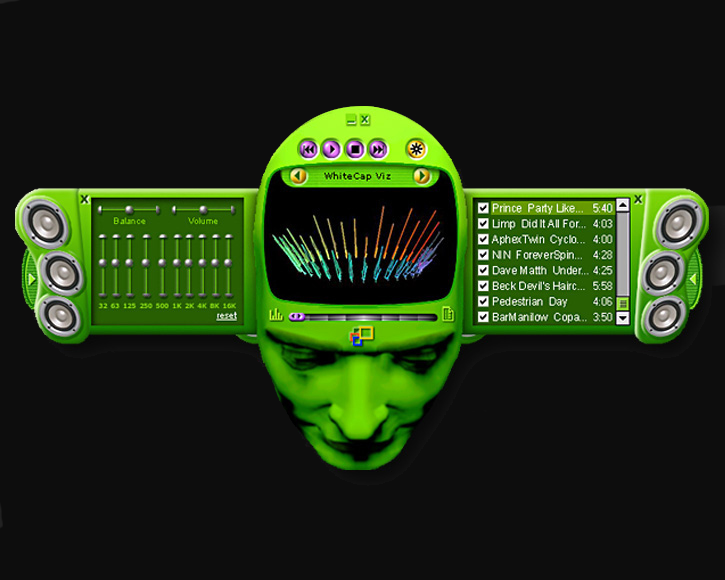Sunday Musings - Whipping The Llama’s Ass
Each week, Adam takes 90 earth minutes to gather his thoughts about a topic. Sometimes, something happens during the week that causes these thoughts. Guess what did it this week, as we travel back to the future of a time long gone.
Let us climb aboard the imagination-copter and remember the early 2000s. Go on. No-one can stop you.
Think back to that glorious neon-lit hinterland between the death of Y2K hysteria and the rise of social media addiction, where pop culture still believed the future would be shiny and optimistic (and maybe sponsored by Nokia).
Float back with me and we shall gently exhume the fluorescent corpse of a design movement that thought we’d all be living on the moon by now:
2000s Retrofuturism.
Retrofuturism, for those who spent the early aughts trapped in a lava lamp or running a Geocities page, is the artistic practice of imagining the future as envisioned in the past. Think of it like vintage science fiction meets IKEA showroom, with a synthwave playlist echoing in the distance. The 2000s version of retrofuturism was a curious beast. It took its cues from the jet-set optimism of the 1960s – all Jetsons hovercars and optimistic Space Age glee – but ran it through the anxious, polycarbonate-plastic lens of the post-Millennium world. Gone were the wood-paneled dreams of 70s sci-fi or the grimdark grime of Blade Runner. Instead, we were promised a clean, cool future full of brushed metal, rounded corners, and interfaces that went bloop instead of beep. See “I, Robot” via Windows 2000's Media Player for full examples.
This was the era of iMacs that looked lickable, MP3 players with no more than 128MB of space, and UI design that could only be described as “Tron but make it stainless steel.” It was an aesthetic movement drunk on optimism and running headlong into a digital age where style and tech were finally trying to hold hands. .
Techwear and Toaster Cars Designers, bless their caffeinated souls, were churning out visions of the future that looked suspiciously like they’d been designed by a committee made up of NASA engineers and Hello Kitty enthusiasts. Everything was curved. Everything glowed. And everything – I mean everything – was silver. Or white. Or some shimmering shade of “cyber lavender.” Cars became became sharp curves on wheels. Phones slid, flipped, and swivelled with the smug confidence of a Bond gadget. Websites full of glorious tables nested in tables, with splash pages and loading bars that looked like they’d been drawn by someone trapped inside a GameCube. The future was here, and it came with a brushed steel fridge that connected to your PalmPilot.
At its heart, 2000s retrofuturism was charmingly naïve. It envisioned a world where tech solved problems rather than monetised your personality. Where we’d be gliding around in pod-like vehicles while sipping nutrient shakes (available in citrus or vanilla!) and working for ethical megacorporations who just wanted to help us live our best chrome-tinted lives. It was clean. It was cool. It was… kind of sterile. That was both its charm and its undoing. Because for all the sleek gadgetry and euphoric Apple ads, real life had a different script in mind. The optimism couldn’t survive the mounting cracks in the digital dream: 9/11 reshaped the global mood, tech turned from sleek toys to invasive trackers, and social media emerged like a freshly unboxed Pandora’s Box full of hot takes and humblebrags.
Retrofuturism, with its hopeful heart and modular furniture, suddenly looked like a museum exhibit. Relevance took a back seat to cool here.
By the 2010s, the aesthetic had all but vanished, relegated to the nostalgia bins of Pinterest boards and fond memory. Design moved on – first to the flat design minimalism of Silicon Valley (Helvetica everything, thanks), and then to the brutalist web revival that made every homepage look like an Eastern Bloc train timetable.
We traded our optimistic future for algorithmic efficiency, our soft-edged gadgets for data-harvesting rectangles, and our stylish user interfaces for dark patterns that practically begged you to accidentally subscribe. And retrofuturism went out as it lived: noble, fabulous, and a little out of touch.
But let’s not be too harsh. The 2000s retrofuturism design movement was a product of its time – a hopeful, sometimes dorky, but always sincere attempt to re-enchant the future.
In an era where design can sometimes feel like it's been boiled down to whichever gradient appeals to the public think-group this week, there’s something refreshing in looking back to the pixelated starbursts, the see-through gadgets, the overdesigned concept cars, and the endless, breathless belief that tomorrow might just be cool.
It wasn’t perfect. It didn’t last.
But it was creative. And maybe, just maybe, that’s what the future needs now.

